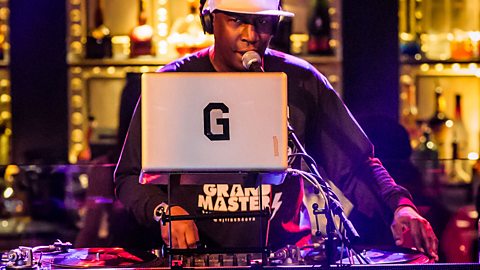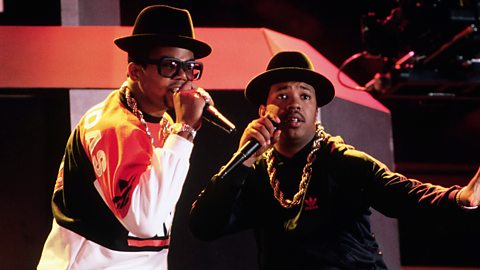Turntablism
Origins
A turntablist is a DJ who creates sounds by manipulating the moving decks and controlling a mixer, as opposed to the more conventional DJ who plays records. This originated in the 1940s with music produced by the experimental composer, John Cage. However, turntablism as we know it today began as part of the hip-hopA musical genre that usually accompanies rapping. movement in the 1970s. The key landmarks in the development are:
Cutting – the DJ has two decks spinning the same record which have a percussion break, called a breakbeat. The technique allows for the break to be repeated as often as required. Since this is a live technique, it is not easy to find recorded examples of this. DJs such as Afrika Bambaataa and Grandmaster Flash are known for this technique.

Afrika Bambaataa - Planet Rock
One of the most well-known techniques associated with turntablism is scratchingUsing the hand to move a record back and forth on a turntable.. There is a story that DJ Grand Wizzard Theodore accidentally discovered the technique by stopping the decks from spinning with his hand while he took a telephone call. This technique was further developed by DJs scratching a deck rhythmically in time to music being played on the other deck.
Fantastic Freaks at the Dixie - Grand Wizzard Theodore
On stage, DJs would originally provide the backing for MCs to rap over. This then gradually began to appear on recordings and work with live and recording musicians.

Tougher than Leather - Run-DMC
These early developments were largely taking place in New York, with DJs in Philadelphia extending the techniques further by creative use of the faderSlide control of sound levels on a mixing desk. to chop rapidly between blocks of sound. This allowed for tonal as well as rhythmic variation.
A Touch of Jazz - DJ Jazzy Jeff
In the 1990s DJs faded from the live performance scene as hip-hop artists chose pre-recorded backingAccompaniment for a singer or solo instrumentalist from a CD or MP3 player. for their live acts, complemented by other musicians and dancers. The movement once more went undergroundMusic that is written to avoid a mainstream commercial approach. . From this emerged the idea of the turntablist, rather than the DJ (who sees their decks and equipment as an instrument in much the same way as a conventional instrumental player). More complex rhythm patterns evolved when musicians started manipulating the decksTurntables used by DJs. and faders together in more sophisticated ways.
More recently, some turntablists have combined the manipulation of decks with the use of other music technologies, such as samplerA unit or piece of software that is designed to record and manipulate samples., drum machines and loopingMusic repeating over and over. software in their performances. Others have abandoned conventional decks altogether, using vinyl emulation softwareAlso known as virtual decks. Software that alters clean digital music to imitate the scratchy sound of vinyl records. software (sometimes referred to as virtual decks) in their place.
Mix Master Mike - Hydrolik Carpet Ride